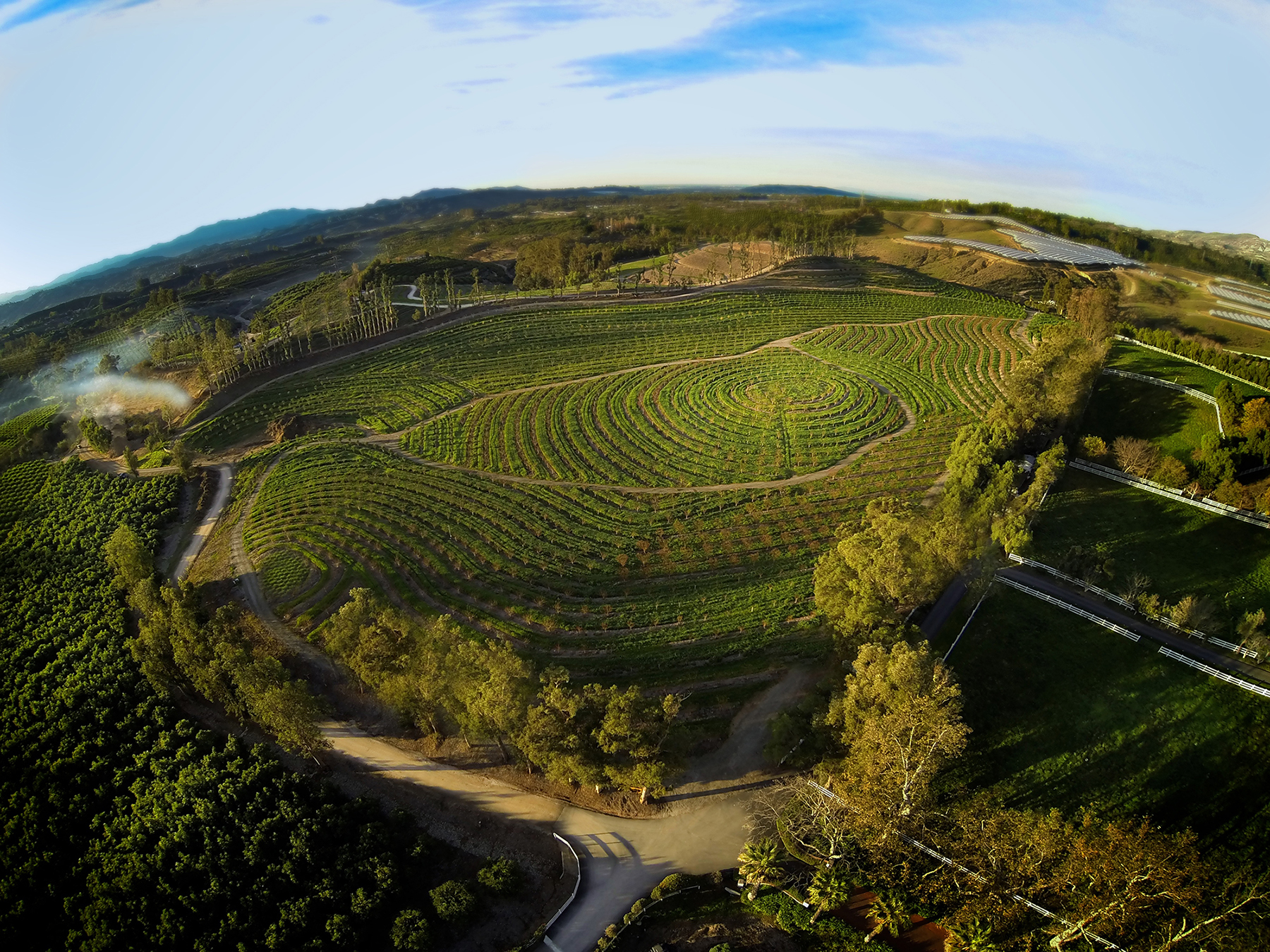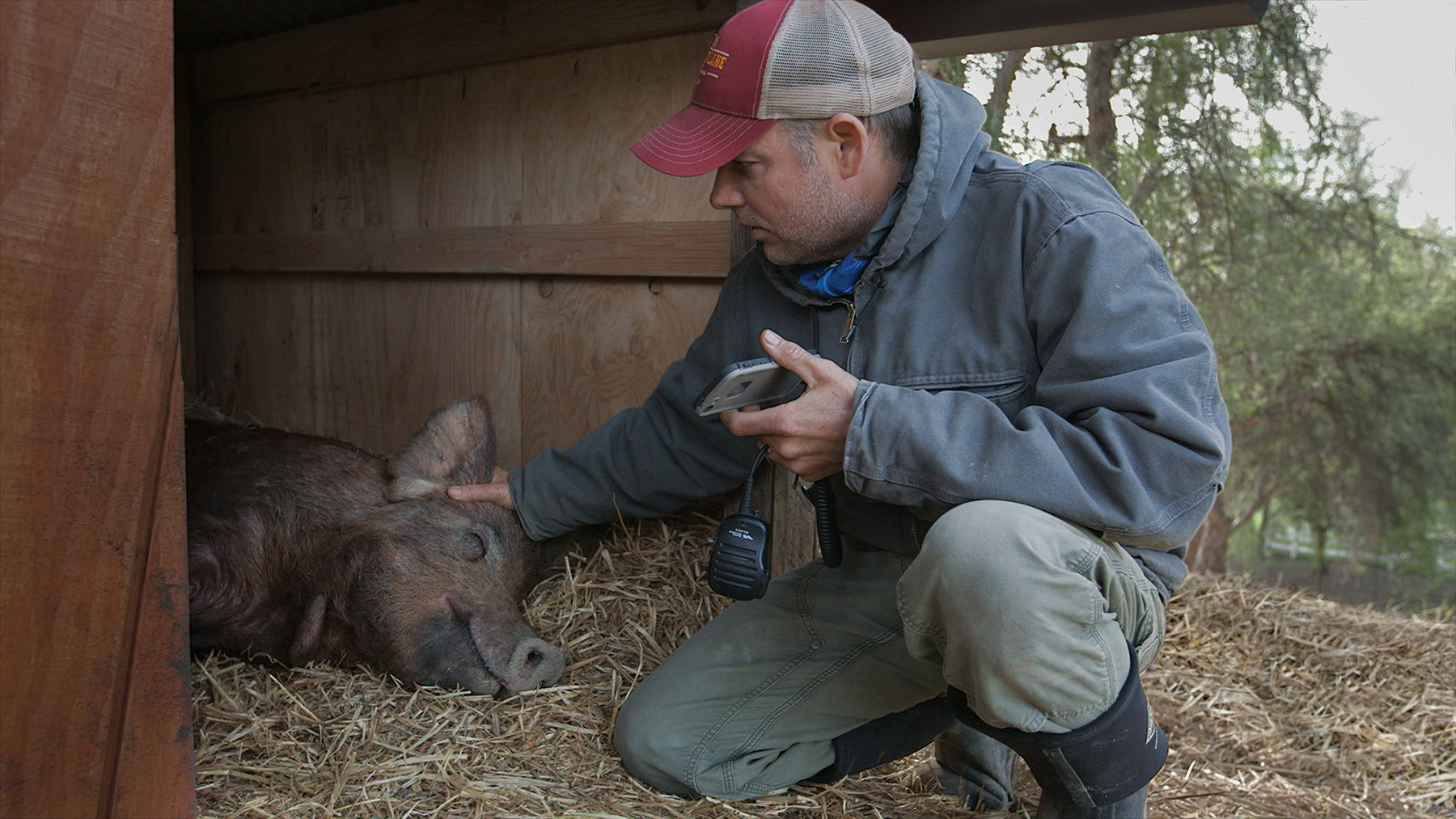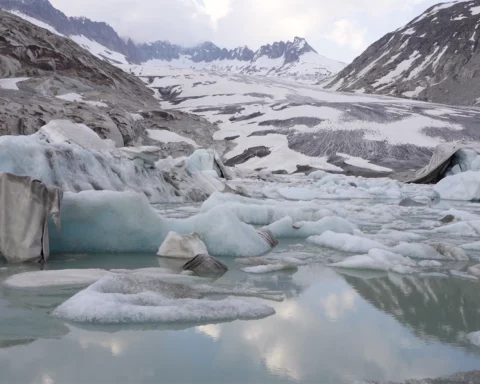A folksy, daydream quality suffuses about half the frames of The Biggest Little Farm, out now from NEON, and showing in artsier cinemas and festivals around the country.
This cinematic pixie dust is the film’s greatest strength. It also risks placing the picture, written and directed by acclaimed wildlife photographer, John Chester, precariously at the edge of fictionalized memoir — not through untruth or exaggeration, but omission and artifice.
The story’s arc traces a couple’s exodus from the city to a nearly barren avocado farm an hour or two north of Los Angeles, in search of that rare fulcrum between Man and Nature. The audience enters Apricot Lane Farms, the movie’s setting, as a wildfires rage on three sides of John and Molly Chester’s gorgeous spread of biodynamically diverse agri-habitat. A sense of panic builds as evacuation plans are set in motion, and the scope of disaster is undeniable as mountains of smoke tower hundreds of feet above the hills in the near horizon. Later, Chester narrates the fact of an historic drought that has been underway for a several years; the audience is left to make the connection for itself.
After the adrenaline rush of an opening, Chester walks the story back to the beginning, when he and his wife, Molly, and their dog, Todd, are in search of a home where the four-legger can be free to be Todd. Molly is a chef and food blogger/photographer who understands, from the beginning, that the important thing about food is how it’s grown. Through playful animation, she pulls a slightly skeptical John into her dream of escaping to the country life. Not to just any farm, though. The quintessential storybook farm that provides space for, well, a little of everything, and a lot of some things.
The problem?
“Molly’s dream could be the answer to everything. We had a great idea…with no way to pay for it.”
Our narrator doesn’t open the couple’s books to the camera, so we’ll just have to take his word for it. On the other hand, the fact that he was slated to create a series of short films for the Oprah Winfrey Network (which won five Emmy Awards), suggest, at least, that he had a pretty good idea that buying a house in the country with room for a dog to play and humans to garden would be within reach soon enough. Clearly, John’s and Molly’s vision was sufficient orders of magnitude greater than that such that “no way to pay for it” was a question of scale.
The answer? Have a crowdfunding party with a couple dozen of your closest friends and family. Oh, and find an investor. A lavish one.
The 200+ acre property the Chesters purchased just west of “Reagan Country” was similar to other abandoned or struggling fruit farms in Ventura County. In fact, if you’re willing to revive a “challenging property,” your own 200+ acre drought-stricken paradise in nearby Santa Paula can be yours for a mere $4 million. And that’s just for the dirt.
The Chesters brought in staff and equipment to make improvements and renovations, building structures and installing systems. John reveals that, after tearing out countless trees, fixing miles of irrigation, and hiring a platoon of young, enthusiastic intern-esque workers, the farm had blown through a 12-month budget in half that time. We don’t know what that budget was, but, between the purchase of the property and the not-quite-terraforming scale of reclamation, we know that it represents staggering amounts of money.
In fact, the speed and scale of the Chesters’ spending brings to mind the old joke, “Wanna know how to break your back farming, but end up with a million dollars in the bank at the end of the year? Well, you start with ten million…”
As the film continues, we see green replace brown. Life from varioius phyla, classes, and orders returned to take advantage of the abundance possible with an aquifer and enough PVC tubing. Under the tutelage of sustainability consultant, Alan York, Apricot Lane Farms becomes distinctly different from many of the mono-cropped parcels nearby. It becomes, in a word, verdant.
Here is where John Chester’s mastery of filmmaking really begins to take over. His camera focuses its eye as lustfully as if it were shooting a lost epic by Tolkien. Through high definition clarity, the audience is treated to breathtaking shots of minor miracles, sigh-inducing panoramic buffets, and the nearly daily, nearly value-neutral Darwinian fight for survival. His camera is seemingly everywhere it should be, always at the right time, with the sun always at the perfect angle, his plant and animal subjects having run through their lines and blocking well in advance. And because Chester is such gifted storyteller, the scenes, almost without exception, reward the audience with a roller coaster series of emotional highs and lows that turn agricultural progress into a fast-moving plot. After what must have been grueling months of editing, a dramatic tale of small farming emerges. Rural life has never been so expertly romanticized.

We see the burning of unproductive avocado trees, but little of the back-breaking labor of re-planting or tedious pruning. We see the heartbreaking trials and reaffirming triumphs of animal husbandry, but almost none of the day to day chores. We see predator species devastate poultry numbers with no understanding of how that affected production quotas or what the implications of purchasing replacement birds might be on the profitability timeline. We become vaguely aware that a dozen or more workers are putting their shoulders to the wheel, but not how the economics of this labor is sustained or what any of the details of their lives might be. We also don’t know much about Molly’s role in the farm, nor do we know what John does when he’s not racing from one end of the farm to the next, responding to crises.
The plot points are artfully painted in luscious strokes of determination, sorrow, celebration, and acceptance. Close-ups have an almost mystical quality that makes for Instagramable perfection (only achievable with enchanted pro-filters you and I don’t have access to). The portrayals of beauty and joy are hi-res masterpieces; the many depictions of tragedies, even more so. The Chesters search for solutions to the unexpected challenges that punch them in the gut over and over, and we, the audience, feel our hearts break for the disappointments and despair we can read on their faces. From the beginning of John and Molly’s journey, we are granted access to intimate, even awkward, moments that obscure the hidden twin goal just around the corner from every dollar spent, every spontaneous laugh, every aching muscle, every shed tear: the creation of the film itself.
Because, really — and this is only going to get a little meta — The Biggest Little Farm isn’t just a film about the restoration of an overworked industrial ag operation into a vibrant, ecologically balanced family farm. It’s a film about the filming of a piece of land being brought back to life—at least in part. What the exact percentage is would be impossible to calculate, because we expect that a talented filmmaker embarking on any personal project is going to allow his professional skills to bleed into his labor of love. But that’s also what makes this picture a documentary whose camera is always pointed at a mirror, usually unobtrusively in the background, but always there just the same. In fact, the probability is that the movie was half of the plan submitted to the investor at the outset. And that makes the work not exactly a documentary, really, but something of a hybrid — a racontumentary, maybe.
The audience has to decide for themselves if they’re okay with that. Some people might decide that it’s too great of a leap to trust the storyteller who has that kind of control over the raw material of the tale. In the end, I have to argue in favor of trusting our narrator, John Chester. To record, with equal parts passion and professionalism, the details of such an experience as the genesis of Apricot Lane Farm, from scratch, could only be achieved by a person with Chester’s insight, talent, and tenacity. His track record of success in film, as will as his wife’s expertise in food, also likely afforded him access to capital that few hardscrabble farming families could even dream of.
The success of Apricot Lane Farms wasn’t a given, which means that Chester couldn’t be sure of how The Biggest Little Farm would conclude. Investors can’t charge in to save orchards, crops, buildings, even animals, when the winds shift, despite all prayer and desperation, and flames surge over the hills and attack like demons. No effects can put a soft warm glow on losses from pests or predators. Nature doesn’t care how fat your bank account is. Luck isn’t impressed by your awards sitting on your shelf.
And this is where John and Molly Chester, and their team, are framed best in the film — as humans, fallible and fragile. Whatever success they may have achieved professionally, when their first breeding sow, Emma, was at Death’s door, they stayed up late into the night, frustrated and fearful, like any other newbie farmer, with nothing but a thin hope and a copy of Storey’s Guide to Raising Pigs you can pick up used for around ten bucks to lean on. Tensions ran high, and a viewer probably couldn’t be blamed for inferring that tempers flared off camera a time or two during the eight year span of the film.

The humanity is captured, too, in the moments of small splendor that present themselves to artists whose talents are bridled by a creative humility. The majesty and worth of the lowliest, even unwelcome, creatures finds its way onto the screen in this film where, more than anything, the protagonists struggle not to impose their will on the landscape, but to understand the will of the land. The realities test the farmers, and the decisions about how they fact that reality tests them even more. Questions of Life and Death are frequent on farms, and we see John, in particular, in an unfiltered state as he navigates the ethics of food of which consumers are largely unaware.
That we so often get to see John reminds us that someone else’s hand is on the camera for most of the movie, not John’s. The filmmaker gets to choose what makes it into the final cut, and Chester chooses to expose some of his shortcomings that got captured, intentionally or not, in high-definition. The story may contain elements of honesty, in fact, that would be very difficult to tease out of a subject in a straight documentary. People typically want to conceal their failures, and the filmmakers job is to try to catch actual characteristics as they are exposed in fortunate moments. In this story, we see the Chesters becoming farmers with a generous honesty — imperfectly.
So I urge audiences to allow themselves to be saturated with the movie’s lush eye-candy. Life at Apricot Lane Farms is, as it is on many farms, full of wonder. The visual storytelling of this endeavor is probably the most devastatingly executed entry into pastoral cinema ever achieved. It is not at all that the 5th generation poor dirt farmer trudges joylessly through her labors without witnessing the unbelievable magic present in the simplest of interactions with the environment. She sees the divine all around her, but she’s forced to keep moving, keep racing the clock and calendar. The best camera, even if the farmer has the skill to use it, is of little use to her. Chester’s network, and abilities in diverse areas such as communications, business plan authoring, and drafting proposals, opened the door for him to be able to bring the world in for a closer view of a life and lifestyle that is precious. And wholesome. And disappearing.
The Biggest Little Farm succeeds in illustrating just how dismally hard life can be in the service of agriculture. But along with the grinding setbacks and regular disagreements with the natural world, the flick provides scenes that demonstrate the the rural life has value, that it needs to be re-examined, that it may hold the key to our survival as a species. Conventional, “get big or get out” farming sneers at the herculean efforts put in by Fifth Wave agriculturalists to undo the damage by reckless soil and pest management. The philosophy used to regenerate Apricot Lane Farms isn’t one of inputs, but interactions. And these interactions are the plot points that propel the the family, the story, and the soil forward into fertility.
When comparisons are made between the Chesters’ approach and that of other farmers in the area, you begin to understand how much of factory farming is about quick returns on investment. American families, who spend a smaller percent of our income on food than any other country in the world. And we like it that way. The short term cost benefits of mono-cropping and synthetic herbicides and pesticides have created concurrent crises of erosion, soil toxicity, water shortages, and super weeds. Food, fast and cheap, from farm to table, may have created one of the costliest and time-intensive emergencies to address in just over two generations.
It took eight years and an unspecified fortune to return a 200-acre tract of land to health through principals of biodynamic stewardship. As a business model, pretty much a non-starter to most investors who are looking to cash out as quickly as possible. When the planet is running a high fever and showing signs of distress, Apricot Lane Farms becomes both microcosm and metaphor for the epic task of realigning humanity’s priorities on a global scale. Those farmers who launch the first campaigns of the necessary agricultural revolution will likely not live long enough to learn whether or not their contributions were enough. Already, in the economic system driving most of the West, it’s hard to see where the financial resources would come from to overhaul our entire food system. If environmentally sustainable farms could restore the health of the land and help dial back the climate emergency (and if they could all be as achingly cute as Apricot Lane), I have no doubt that most Americans would voluntarily spend more on their food. How much more is hard to gauge. And that’s why I wish the Chesters had been a bit more transparent about the funding for their project.
Would it dilute the rhetorical force of their cinematic argument? Maybe. But maybe not. When a known hefty expense is on family’s budget, they’re more likely to start saving well in advance, realizing that coming up with the money at the last minute will be highly unlikely. If the size of the bill is downplayed, the seriousness is proportionately ignored. I think the seriousness of the breakdown of our food systems has been ignored quite long enough, thank you.
In all, The Biggest Little Farm is a tour-de-force of filmmaking. If John Chester puts away his camera for good and sticks to tending his stone fruit, he will owe the world no more of his artistic talents. The film portrays the most uplifting and the most dismaying aspects of farm life (even if it lacks a bit of what’s in between) with grace. To a one, every scene where another director might have been heavy-handed, Chester spreads just enough pathos to pluck at the audience’s heartstrings without breaking them. Viewers who grew up on a farm and lost their way (or lost their farm) should be prepared to spend two hours in an emotionally fragile state. Lifelong urban-dwellers may have to be reassured that yes, those vibrant colors really do exist in nature. And anyone who understands the immediate danger in which humans have placed every living thing on Earth will likely feel equal parts urgency and hope — probably John Chester’s greatest, and unexpected, accomplishment with this important work.

















Beautifully, and accurately written!!!
Thanks, Mark! It really is a moving story.